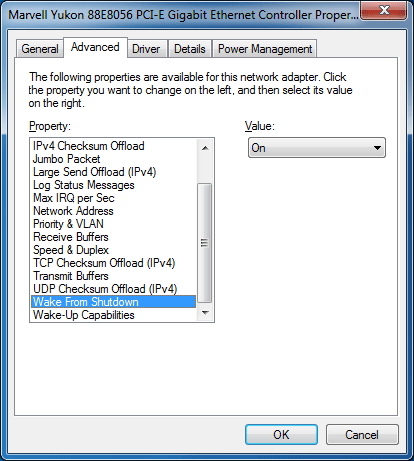I had a laptop at home that I didn’t really use much. I realized that I could save some power if I only power it on only when I need it.
Wake On LAN
Supports Wake-on: Pubg
The target computer's motherboard and Network Interface Controller have to support Wake-on-LAN. The target computer has to be physically connected (with a cable) to a router or to the source computer for WoL to work properly. Some wireless cards have support for Wake on Wireless (WoWLAN or WoW). The broadcom part identify link but the i210 does not, see ethtool response: Supported ports: FIBRE Supported link modes: 1000baseKX/Full Supported pause frame use: Symmetric Supports auto-negotiation: Yes Supported FEC modes: Not reported Advertised link modes: 1000bas.
I remember that I can use Wake On LAN (WOL) to power on a machine over the network, only if the NIC supports that. I checked out the model of the old machine:
Then after checking out the specs of the laptop luckily it had this option available. So I enabled that in the BIOS:

Supports Wake-on D
WOL NIC Support

Then after I powered it on, I confirmed it’s enabled on the NIC:
We can see the Supports Wake-on and Wake-on options are set appropriately.
Using a WOL Client to the Send Magic Packet
I figure out what the MAC address is:
Then I just powered off the machine:
Then on my mac, I went ahead and installed the WOL client:
Then I went ahead and sent the magic packet:
and I kept a ping going and after some time the machine booted up:
On my CentOS machine I just ended using ether-wake which is part of thenet-tools rpm:
And executing the following accomplished the same thing:
WOL Over a Router
I was running the command from machines that were on the same subnet as thedestination host. If you are traversing a switch or a router make sure those devices support passing the magic packet across and allow directed broadcasts.Here are some nice steps laid outfor dd-wrt. I will stick with local subnets :)
I don't know if you lost interest or if you solved this already but here's a datapoint of my own: recent(1) kernels make my desktop system(2) reboot instead of shutdown, I have not bothered to look into it because I don't use it very often but after your inquiry I decided to look into my own problem.
It seems that for some systems, having 'Resume by pci device pme' will cause the machine to reboot instead of shutdown, and indeed after looking into the bios setting on my desktop system I had that enabled. If anything I'd say that this behavior may be a mix of a wonky bios and a kernel regression.
(1) Can't say for sure when this started happening, but current Arch kernels do this (didn't try LTS though), both windows xp and 7 work as expected. The current kernel shipped by CentOS 6 (2.6.32-431) also shuts down the machine as expected so you might want to try a livecd of a distro with an older kernel to see if the problem goes away.
Proxmox 6 Wake On Lan
(2) The machine is getting old and is starting to misbehave so initially I dismissed the wonky behavior as some early impending failure sign.
